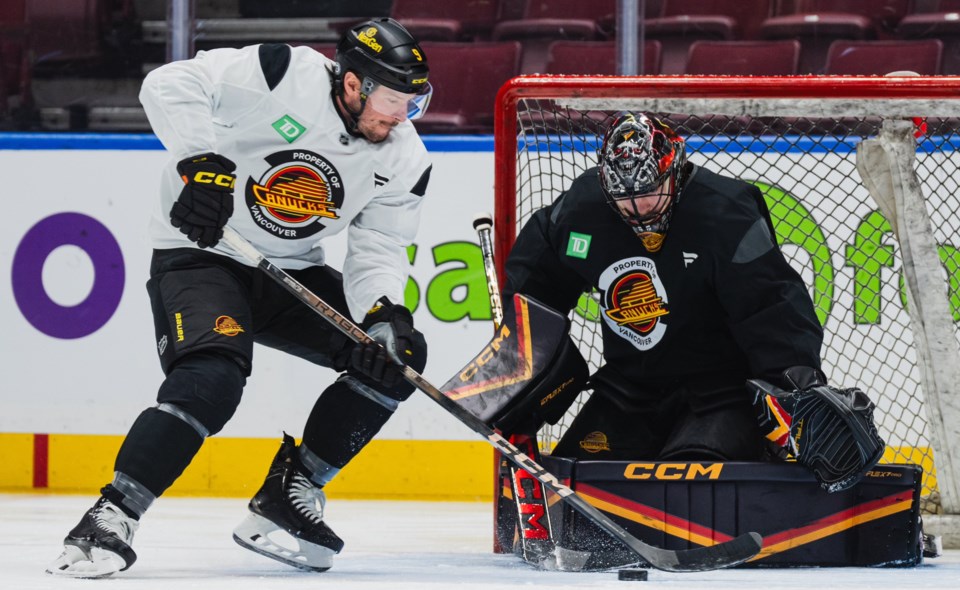It’s been three weeks since the Vancouver Canucks made a blockbuster trade, sending J.T. Miller to the New York Rangers.
That’s probably not enough time to properly reckon with Miller’s tenure with the Canucks, especially since some elements of what occurred behind the scenes are still unknown. Certainly, his full-throated enthusiasm over receiving a phone call from Donald Trump will affect how some Canucks fans view him but, for the moment, let’s focus on what he did on the ice with Vancouver.
Some have argued that Miller should someday be added to the Canucks’ Ring of Honour alongside Orland Kurtenbach, Kirk McLean, Thomas Gradin, Harold Snepsts, Pat Quinn, Mattias Ohlund, Alex Burrows, and Roberto Luongo.
It’s not an outrageous suggestion. He left the Canucks second in points-per-game in franchise history behind only Pavel Bure, who did more than just end up in the Ring of Honour — his number 10 was retired by the Canucks in 2013.
Miller’s best season came in 2023-24 when he put up 103 points in 81 games, which is the seventh-best season ever by a Canuck. All but one of the five players who scored more points for the Canucks in a single season have their numbers retired by the team.
But that one exception is illustrative of how Miller might be viewed by Canucks fans in the future. Miller’s legacy with the Canucks could end up being very similar to that of Alexander Mogilny.
Miller and Mogilny had similar tenures with the Canucks
There are some significant parallels between the two players and their time spent in Vancouver.
The Canucks traded for both Miller and Mogilny at the age of 26, bringing them to Vancouver in their primes. Miller lasted five-and-a-half seasons, while Mogilny lasted four-and-a-half seasons.
Obviously, there's a difference between the two in regards to when they were acquired: Mogilny was already a star when he came to Vancouver. He had an incredible 76 goals in 77 games for the Buffalo Sabres in the 1992-93 season when he was just 23 years old.
Miller didn’t come with the same cachet, but he quickly established himself as a star with the Canucks, leading the team in scoring with 72 points in 69 games in his first season, then growing his game to putting up 99 and 103-point seasons.
Like Miller, Mogilny had a 100+ point season with the Canucks, putting up 55 goals and 107 points in the 1995-96 season, which is fourth-best in franchise history. Mogilny also exited the Canucks with the second-best rate of points-per-game in franchise history at the time behind Bure and is now third behind Miller.
Mogilny led the Canucks in scoring in two of his four-and-a-half seasons: 1995-96 and 1996-97. Miller did the same in three of his five-and-a-half seasons: 2019-20, 2021-22, and 2023-24.
But beyond the numbers, the biggest parallel between the two is that the Canucks never lived up to expectations during their tenure.
Two Canucks teams that failed to live up to expectations
Both Miller and Mogilny were star players for the Canucks during a turbulent era in franchise history. For Mogilny, it was the Mark Messier/Mike Keenan years, while Miller was in Vancouver for the end of Jim Benning’s mismanagement and the troubled transition from coach to coach that brought the team to its present state.
Expectations were high when the Canucks brought in Mogilny. When the Canucks acquired him, they were just one year removed from going to the Stanley Cup Final in 1994. Adding him to a roster that already included Pavel Bure along with most of the core that came within one game of the Cup was supposed to take the Canucks over the top, as was the addition of Messier two years later.
Instead, after making the playoffs in Mogilny’s first season in Vancouver, the Canucks missed the postseason for the next four seasons.
Similarly, with Miller added to Elias Pettersson and Bo Horvat up the middle, not to mention Quinn Hughes on defence and Thatcher Demko in net, the Canucks in Miller’s time had all of the basic ingredients of being a Stanley Cup contender. Instead, they could barely make the playoffs.
The Canucks made the playoffs in Miller’s first year with the Canucks — if only just barely thanks to a play-in qualifying round after the season was cut short by COVID — then missed the playoffs in three straight years. They did get back to the playoffs last year under new management and came a game away from making the Conference Final but they’ve played well below expectations this season prior to Miller getting traded.
At least Miller was good in the playoffs for the Canucks when he got the opportunity, putting up 30 points in 30 games and tying for the team lead in playoff scoring each time. Mogilny also led the Canucks in scoring in their one playoff series in his time with the team, putting up 9 points in 6 games.
Both teams were also marred by in-fighting, as Mogilny saw a room divided by Mark Messier and Mike Keenan, while the Canucks’ own president of hockey operations confirmed the rift between Miller and Elias Pettersson, though general manager Patrik Allvin said it wasn’t just about those two players.
Ultimately, Miller and Mogilny saw their time with the Canucks come to an ignominious end. Their final seasons in Vancouver are remarkably similar, with both putting up a similar amount of points before getting traded to the Tri-State area. Mogilny tallied 38 points in 47 games before he was traded to the New Jersey Devils, while Miller had 35 points in 40 games when he was traded to the New York Rangers.
As for what the Canucks got from those trades, the Mogilny trade led directly to a key piece of the team that brought a lot of Canucks fans back.
Instead of prospects or draft picks, the Canucks got a pair of 24-year-old forwards from the Devils for Mogilny: Brendan Morrison, who became a central figure in the West Coast Express era of the Canucks, and Denis Pederson, who did not. Morrison was the defensive conscience between Markus Näslund and Todd Bertuzzi, as the team once again became relevant in the NHL.
In comparison to the Mogilny trade, the Canucks got a lot more back for Miller: Filip Chytil, prospect Victor Mancini, and a first-round pick that was flipped for Marcus Pettersson and Drew O’Connor. Will any of those four players have the same impact as Morrison did? The Canucks can only hope.
What will be Miller's legacy with the Canucks?
So, will Miller’s legacy be similar to that of Mogilny?
Both were great players on terrible teams. Mogilny is a favourite of some Canucks fans, just as Miller will surely be a favourite for many Canucks fans in the future.
Both were questioned for their defensive effort at times, with Mogilny getting the “enigmatic” label, while Miller was far more mercurial in his emotions.
Both players will have their statistics enshrined among the best in franchise history far into the future.
But Mogilny doesn’t have his number retired and isn’t in the Ring of Honour. When it comes to all-time Canucks greats, he might get a mention, but more as an aside rather than a real part of the conversation.
Part of that is simply longevity, as he didn’t last long enough with the Canucks to be an all-time great, while a bigger part is that the team never saw success while he was on the roster.
The same seems to be true of Miller. Is five-and-a-half season in Vancouver long enough to be an all-time great Canuck? Did the Canucks go far enough in the playoffs to make his accomplishments stick in the memory of Canucks fans for decades to come?
With that in mind, Miller’s legacy with the Canucks feels like it belongs right alongside Mogilny’s: a great player but not worthy of any great honour in Canucks history.




